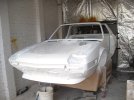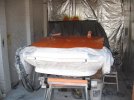Jonohhh
True Classic
Getting ready to chase a constant key-off full 12v draw on the '75.
- It's not the alternator.
- It's not the starter.
- It's not the radio memory/clock.
- It's not the courtesy light.
- It's not on any fused circuit.
Everything on the X operates properly and nothing operates in the key-off position that shouldn't. This should be a real adventure, probably involving some body contortions not normally found in nature......
Interesting for sure, do you have any idea how much current it's pulling?


